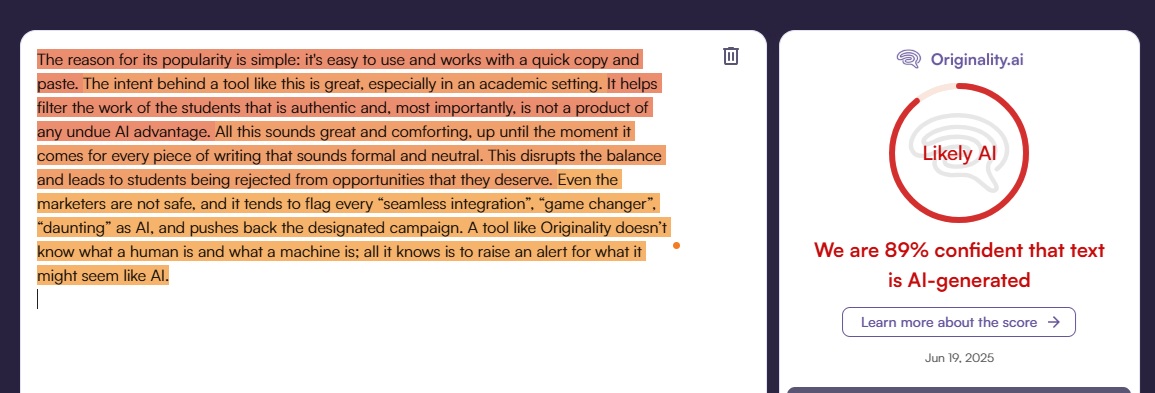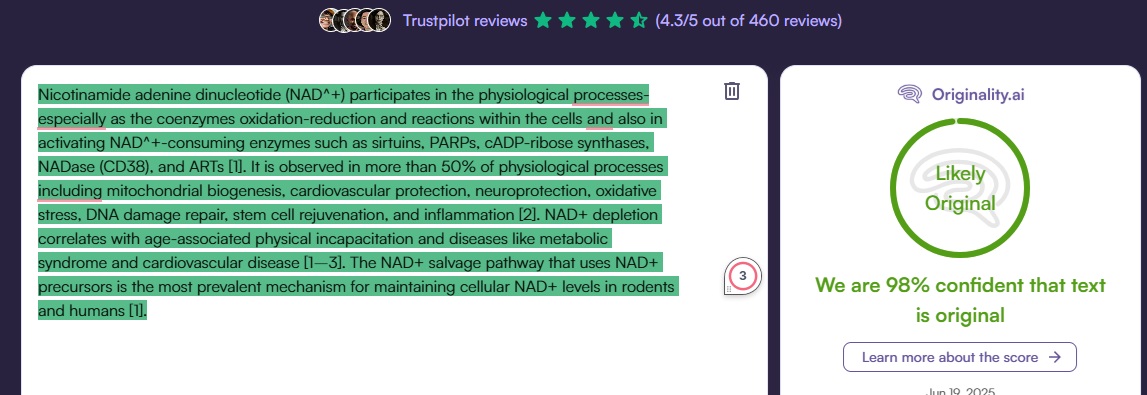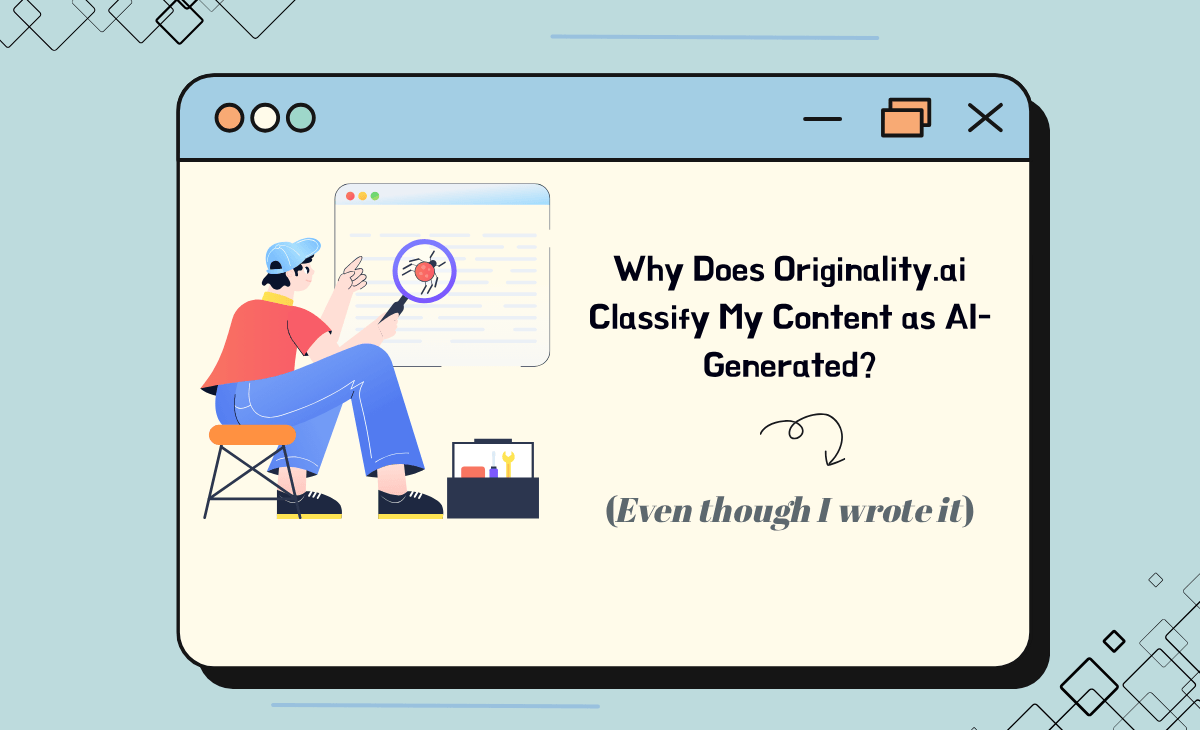It is scary to be flagged by a detector that references patented technology and is one of the best-known tools on the market. It makes you question your work rather than the detectors' efficiency. But by the time you realize the problem might be somewhere else, it's usually too late.
Either you are rejected from the academic forum, or your marketing client rejects your entire copy. Now, one can only vouch for originality in a situation like this or try every possible hack to overcome the Originality.ai false positive issue.
You cannot convince your client or a professor of a reputed institute to change from Originality.ai, claiming that it malfunctions. But you can surely understand the loopholes around it and make sure nothing comes to disregard your credibility.
Here is the thing: AI detectors are simple; they pick up patterns and phrases. If you wish to outsmart them, all you need to do is understand them on a deeper level to help protect your human-written work.
What is Originality.ai?
Originality.ai is an all-in-one tool that can help you maintain your writing integrity. It promises to check for plagiarism and facts, but it's mainly known for its AI detection. To put it in simpler terms, Originality.ai helps you detect the presence of AI in a given piece of writing.
The reason for its popularity is simple: it's easy to use and works with a quick copy and paste. The intent behind a tool like this is great, especially in an academic setting. It helps filter the work of the students that is authentic and, most importantly, is not a product of any undue AI advantage.
All this sounds great and comforting, up until the moment it comes for every piece of writing that sounds formal and neutral. This disrupts the balance and leads to students being rejected from opportunities that they deserve.
Even the marketers are not safe, and it tends to flag every “seamless integration”, “game changer”, “daunting” as AI, and pushes back the designated campaign. A tool like Originality doesn’t know what a human is and what a machine is; all it knows is to raise an alert for what might seem like AI.
How does Originality.ai work? (And Where It Can Go Wrong)
We all have face recognition on our phones. Every time your lock screen detects your face, it unlocks the phone. Now, it can’t know if you are opening it under pressure or just scrolling through like always. It can't differentiate unless you have some special alert enabled.
That’s exactly how a detector like Originality.ai works. It doesn’t understand the intent behind a phrase or word; it only knows that the word needs to be flagged.
BERT: It relies on Google’s concept of a language brain and is designed as a sophisticated system for themselves. So, like any other detector on the market, they fed the model tons of real human writing and AI-generated writing from tools like GPT-3 and GPT-J to highlight the difference.
To sharpen the model’s skills, they trained it first with a massive 160 GB of text, then fine-tuned it using millions of real and AI samples. They also added variations like temperature, top-k, nucleus sampling, and others.
But to understand its efficiency on a real-time basis, I put the detector to the test on the excerpts from this blog itself. This is what it had to say:

I was expecting Originality AI detection to go wrong, as I have used phrases like “seamless integration”, “game changer”, and “daunting” to establish a sentence. But this is where it becomes concerning: I had used those words as an example and not to carry my sentence forward. Even if I had done so, this was not supposed to be labeled as AI.
Now, think about this from an academic or marketing perspective: you give it your all only to be penalized for using phrases that are popular or polished. The problem is that while the tool is impressively trained and highly accurate in many cases, it still treats certain phrases and sentence structures as red flags regardless of the context.
Top Reasons Why Your Human-Written Content Might Be Flagged
Here is a fun fact that might blow your mind when it comes to AI detection being good at English, it can be an issue. If you are too grammatically sound or your sentences rely on filler, Originality might think you are using AI.
For AI, it always tends to assume that human-generated content is conversational and diverse. It is yet to grasp the concept that, as humans, we can modify our tone and voice however we wish. This lack of understanding is what creates a gap between us and artificial intelligence. This is how it works for AI:
Overuse of Passive Voice
The first and obvious giveaway of AI-generated content is mechanical writing. Phrases like “The task was completed” or “The solution was implemented” have no clear subject and make the content sound a bit rigid and robotic. This overuse of a passive tone is one of the major triggers for a tool like Originality.ai.
Lack of Personal Narrative
Anyone who relies on an AI tool for their writing knows how big of an issue this is. Due to the lack of a lived experience, you will never find an AI sharing a personal anecdote. So, you will rarely find any change in the tone of the writing or any new reflection when reading AI-generated content.
A detector like Originality.ai tends to pick up on these cues and applies them the moment it scans a research paper or a crisp technical blog. Here is a quick example of how frustrating and alarming a false positive can be within a setup like this.
This is how Originality.ai reacted to the paper “Nicotinamide mononucleotide supplementation enhances aerobic capacity in amateur runners: a randomized, double-blind study” by the National Library of Medicine written by Bagen Liao 1,#, Yunlong Zhao 2,#, Dan Wang 1,2, Xiaowen Zhang 3, Xuanming Hao 4, Min Hu.

A situation like this is indeed scary, as it might lead to even termination for students who are trying to make their mark. Not to mention the ones who struggle day and night to get ahead of their deadline. This wrongful flagging of human-written content creates panic and frustration and can even demotivate students to the point of just giving up.
Keyword-Stuffing or Repetitive Phrasing
The marketing people are not even safe from incorrect detection. When a human writer tends to use the same phrase multiple times to emphasize a point or improve searchability, the detector might interpret it as robotic. As you have seen earlier, the moment I merely cited commonly used phrases often associated with AI, Originality.ai flagged the content as robotic. It failed to consider the context and intent behind their use.
Overly Balanced Paragraph Length and Flow
You will rarely find a human-written piece that maintains a perfect mix of identical sentence lengths, consistent rhythm, and tidy transitions. Even in academic or technical writing, we naturally modulate our sentence structures to express our thoughts more clearly. But the moment we move away from this organic narrative and aim for precision and balance, AI detectors tend to get triggered. They don’t expect humans to be that uniform.
Unusual Sentence Patterns or Vocabulary
If you love to enrich your vocabulary, a detector like Originality.ai will never like you. If you use unexpected metaphors, rare idioms, or unconventional sentence structures, detectors might mistake it for AI trying to “sound human.” As for them, any instance of refined creativity is just artificial intelligence trying its hand at being a human.
Best Practices to Avoid Being Flagged by Originality.ai
Now that we know what triggers a tool like Originality.ai, it is important to understand how we move past its challenges. It is disheartening to vouch for the credibility of your hours of hard work. But sometimes it is better than being rejected on something that’s a technical failure like this one.
What Originality AI is exhibiting right now is more of a technical glitch of not being able to understand the intent behind a given text. So, if you wish to counter this problem, you need to think from a technical aspect.
- Write in First-Person POV where Possible: AI shies away from telling a story directly to its readers. You will find the habitual use of “you” now and then, but that’s it. It never really feels like it’s speaking to you, just vaguely in your direction. So you have to adopt a personal tone in your writing if you wish to bypass detection.
- Add Storytelling or Lived Experience: Machine-generated writing only relies on shared experiences. AI doesn't know what being rejected for submission feels like or how important a deadline is. So, the moment you slip in a relatable story that is uniquely yours, something specific, emotional, or reflective, it breaks the pattern and helps your writing stand out as a human.
- Vary Structure and Tone: As we were discussing earlier, a detector will start raising red flags if every sentence sounds the same. So we need to show there’s an actual person behind the words. Hence, breaking down your flow or mixing up the sentences is usually a great way to bypass the detectors.
🚨These solutions are insightful, but if you think about them on a practical level, you cannot implement them everywhere. You cannot add a personal story to academic research or shift the tone in a technical blog. That’s just not how those formats work!
It needs to go beyond “write like a human”. This is where HumanizeAI.io comes in with a smarter and more efficient way to refine your content. But keep your voice and intent intact.
How Humanize AI Helps You Beat False AI Flags
Humanize AI understands the obvious triggers of a popular detector and works its way around it. The challenge of using ChatGPT or any other writing tool in a situation like this is that it will be futile. They are designed to take ownership of your entire work. That includes changing your voice, intent, and the nuances that reflect your individuality.
But Humanize AI doesn't work this way. It knows your struggles and understands that it has to step in only when it’s required. So, instead of changing your entire content for you, all it does is get rid of the obvious giveaways.
We all know that it is not possible to keep a checklist of all the words and phrases that AI can use when you write. It interrupts the process and, more importantly, restricts you with a fear of being mislabeled. That’s why, when you use Humanize AI for a situation like this, all it takes is a copy and paste to get the job done.
To put this theory to the test, I ran the mislabeled paper through our tool. Here are the updated results from Originality.AI look now:

▶️With Humanize AI, not only is the original intent and informational nature of the paper preserved, but the tool also makes a conscious effort to maintain the tone throughout.
Stay Human, Even When the Tools Don’t See It
The only ray of hope in a situation like this is that you aren’t alone in struggling to prove your credibility. Thousands of students, marketers, and writers around the world face a dilemma like this each day. So the most important thing that you need to understand here is that there is no need to panic.
The Originality.ai false positive issue is a widespread one, and it can be avoided if we stay consistent in how we write, careful in how we edit, and aware of which tools can help us overcome these false violations easily.

